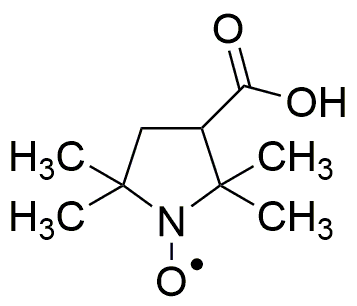3-Carboxy-PROXYL is widely utilized in research focused on:
- Biochemical Studies: This compound serves as a spin label in electron paramagnetic resonance (EPR) spectroscopy, allowing researchers to study molecular dynamics and interactions in biological systems.
- Antioxidant Research: Its ability to scavenge free radicals makes it valuable in studies investigating oxidative stress and the development of antioxidant therapies in various diseases.
- Drug Development: Used in the formulation of pharmaceuticals, it helps in understanding drug stability and interactions, enhancing the efficacy of new medications.
- Polymer Science: In the field of materials science, it is employed to investigate polymer structures and properties, aiding in the design of advanced materials with specific functionalities.
- Environmental Monitoring: This compound can be utilized to assess the oxidative status of environmental samples, contributing to studies on pollution and its effects on ecosystems.
Informations générales
Propriétés
Sécurité et réglementation
Applications
3-Carboxy-PROXYL is widely utilized in research focused on:
- Biochemical Studies: This compound serves as a spin label in electron paramagnetic resonance (EPR) spectroscopy, allowing researchers to study molecular dynamics and interactions in biological systems.
- Antioxidant Research: Its ability to scavenge free radicals makes it valuable in studies investigating oxidative stress and the development of antioxidant therapies in various diseases.
- Drug Development: Used in the formulation of pharmaceuticals, it helps in understanding drug stability and interactions, enhancing the efficacy of new medications.
- Polymer Science: In the field of materials science, it is employed to investigate polymer structures and properties, aiding in the design of advanced materials with specific functionalities.
- Environmental Monitoring: This compound can be utilized to assess the oxidative status of environmental samples, contributing to studies on pollution and its effects on ecosystems.
Documents
Fiches de données de sécurité (FDS)
La FDS fournit des informations de sécurité complètes sur la manipulation, le stockage et l’élimination du produit.
Spécifications du produit (PS)
Le PS fournit une description complète des propriétés du produit, notamment sa composition chimique, son état physique, sa pureté et les exigences de stockage. Il détaille également les plages de qualité acceptables et les applications prévues du produit.
Certificats d'analyse (COA)
Recherchez des certificats d'analyse (COA) en saisissant le numéro de lot du produit. Les numéros de lot et de lot se trouvent sur l'étiquette d'un produit, après les mots « Lot » ou « Lot de fabrication ».
Numéro de catalogue
Numéro de lot/série
Certificats d'origine (COO)
Ce certificat d'exploitation confirme le pays dans lequel le produit a été fabriqué, et détaille également les matériaux et composants utilisés et s'il est issu de sources naturelles, synthétiques ou autres sources spécifiques. Ce certificat peut être requis pour les douanes, le commerce et la conformité réglementaire.
Numéro de catalogue
Numéro de lot/série
Fiches de données de sécurité (FDS)
La FDS fournit des informations de sécurité complètes sur la manipulation, le stockage et l’élimination du produit.
DownloadSpécifications du produit (PS)
Le PS fournit une description complète des propriétés du produit, notamment sa composition chimique, son état physique, sa pureté et les exigences de stockage. Il détaille également les plages de qualité acceptables et les applications prévues du produit.
DownloadCertificats d'analyse (COA)
Recherchez des certificats d'analyse (COA) en saisissant le numéro de lot du produit. Les numéros de lot et de lot se trouvent sur l'étiquette d'un produit, après les mots « Lot » ou « Lot de fabrication ».
Numéro de catalogue
Numéro de lot/série
Certificats d'origine (COO)
Ce certificat d'exploitation confirme le pays dans lequel le produit a été fabriqué, et détaille également les matériaux et composants utilisés et s'il est issu de sources naturelles, synthétiques ou autres sources spécifiques. Ce certificat peut être requis pour les douanes, le commerce et la conformité réglementaire.


